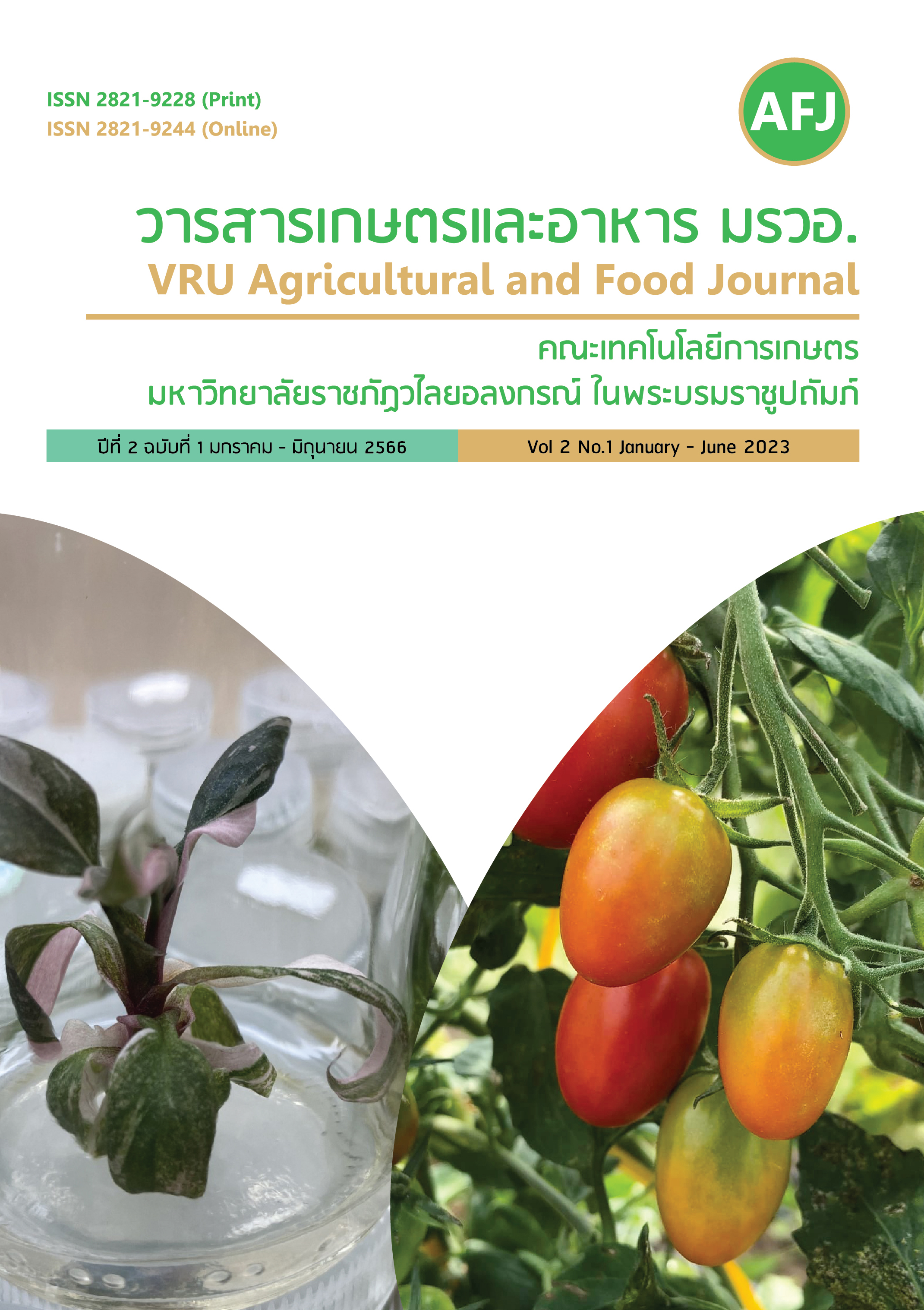Utilization of Napier Grass and Fresh Vegetable Scraps as Bio-extract: Total Bacteria Count and pH Value
Main Article Content
Abstract
Napier grass is a high yielding grass commonly uses as a forage in various ways according to the appropriate harvesting period. But if at the age or plant components of cannot be utilized, it may become agricultural waste as well as leftover vegetable scraps from fresh markets that are plentiful nowadays. Finding simple ways to manage the agricultural waste and align with the BCG economic concept is interesting. One of them is to make bio-extract for agricultural use. Therefore, this study aimed to study the basic properties of the bio-extract obtained from napiergrass and fresh vegetable wastes, namely a microbial content and a pH value at two fermentation periods. The experiment was planned as an independent t-test. The trial was divided into two groups with six replicates each. Group one; fermented for 21 days and group two fermented for 28 days. The results showed that that the two groups of bio-extract were different in the total bacteria content that were 22.5×106 and 5.76×106 cfu/g, respectively (P<0.05). Whereas the pH content reviewed at 4.11 and 4.42, respectively (P>0.05), which is close to the pH value of general bio-extract used today. Extending the results by testing the efficiency of the bio-extract both chemical and physical should be continued for more benefits. Finally, it seems to be another way to take advantage of agricultural waste to create zero waste, reuse, recycle and upcycle in agricultural sector.
Article Details

This work is licensed under a Creative Commons Attribution-NonCommercial-NoDerivatives 4.0 International License.
This article is published under a Creative Commons Attribution-NonCommercial-NoDerivatives 4.0 International License (CC BY-NC-ND 4.0), which allows others to share the article with proper attribution to the authors and prohibits commercial use or modification. For any other reuse or republication, permission from the journal and the authors is required.References
Buayam, S. 2011. Principles of Efficient Fertilizer Production. 2nd Edition. Kasetsart University, Bangkok. (in Thai)
Kongjak, P. and K. Umpuch. 2019. Silage quality between purple napier grass and pakchong 1 napier grass added with fresh leucaena leaves. In The Proceedings of the 7th Academic Science and Technology Conference 2019, Rangsit University, Pathumthani, Thailand, 7 June 2019. 322-326. (in Thai)
Kromrattanaporn, P. 2010. Making Bio-extract Water and Herb. 1st Edition. Faculty of Veterinary, Khon Kaen University. (in Thai)
Nobamornbodee, A., Isaranurak, S., Chompunich, S., Likkananont, P., Kanlong, N., Charoensathaporn, R., and Bhromsattha, R. 2004. Science Data: Bio-extract water (Part 1). Department of Agriculture. 1st Edition., Quick Print Offset, Bangkok. (in Thai)
NXPO. 2023. BCG Economy. The Office of National Higher Education Science Research and Innovation Policy Council. https://www.nxpo.or.th/th/bcg-economy/# 30 April 2023.
Pornpisuthimas, S., Limchuwong, S., Laloknam, S., and Laohakoat, T. 2009. Effects of Bio-Fermentation on The Growth of Fabaceae Plants. 4th Edition. Neon Book Media, Bangkok. (in Thai)
Sarnrakkit, S. 1999. Bio-extract Fertilizer. Thailand Institute of Scientific and Technological Research. (in Thai)
Sutthitham, W., Phosri, P., and Washirapattama, N. 2004. Effects of bio-extract water on growth and yield of fresh bean pods in hydroponics system. Faculty of Science and Technology, Thammasat University. (in Thai)
Umpuch, K. 2021. New developments in forage crops production in Thailand. 40th Malaysian Society of Animal Production Annual Conference “Livestock industries surviving the COVID-19 pandemic”. 3rd – 4th August 2021. 50-58. Online Conference.
Umpuch, K., K. Kokkhuntod, P. Chuchuy, P. Pangsri and P. Pangsri. 2019. The study of chemical components and quality of microorganisms in napier grass silage at different ensiling periods. In The Proceedings of the 13th National Conference of Rambhai Barni Research, Chanthaburi, Thailand, 19 December 2019. 631-637. (in Thai)


